UPS
compatibility
Working together with our APC SmartUPS SC
620, this PSU was stable at load levels up to 405 watts when running by the
power source but only able to switch to the UPS’s batteries at loads up to 290
watts.
The voltage stability

Voltage
fluctuation
The X-1050 is partly worse in this test
than the models discussed above; its +12 V voltage is outside more than the
required level of 1% at low loads. When there is high load on the other voltage
ranges, the voltage range decreases more than 2%. On the other hand, this PSU
is better than the previous X series products if considered in this respect.
Output voltage ripples
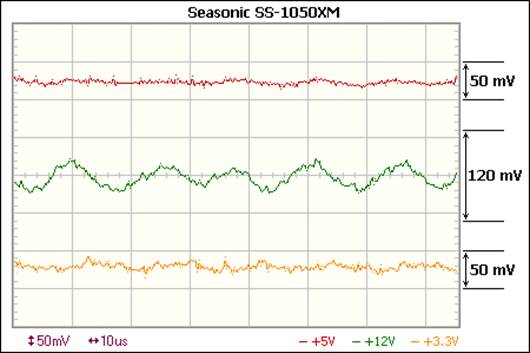
The
graph describes the output voltage ripples.
The high-frequency voltage ripple can be
compared with the new models we have tested above (it is a bit stronger than
the +12 V voltage range and slightly weaker on the +5 V voltage range) but
worse than the previous Seasonic products.
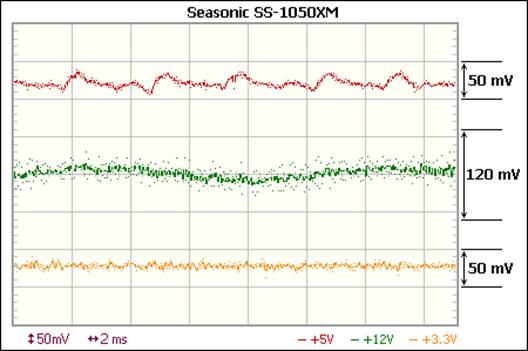
The
graph describes the output voltage ripples.
The low-frequency ripple is quite strong on
the +12V voltage (like the sources discussed above) and on the +5V voltage
range, but always stays within the allowable limits. On the +3.3V range, it is
rather weak.
Temperature and noise
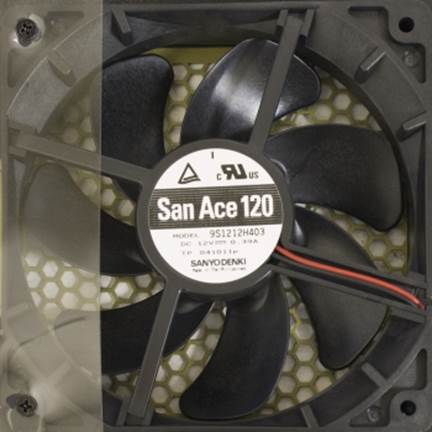
PSU’s
fan
As the KM3 model discussed above, this
model is cooled by a fan of Sanyo Denki San Ace 120 (the number of component:
9S1212F404, rated speed 2,200 RPM) and has a switch to select between the
Normal and Hybrid operating modes.
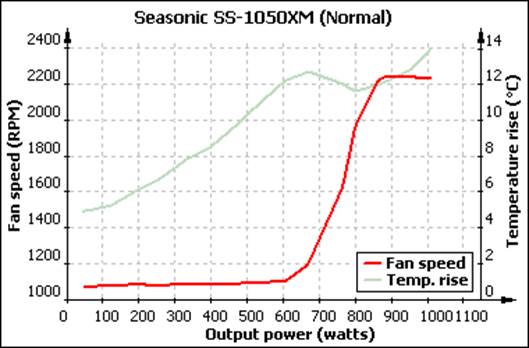
The
graph of temperature and fan speed factors
In the Normal mode, the fan operates like
in PSUs as discussed above, except that its initial speed is very high at
almost 1,100 RPM. The fan attains its highest rated speed of 2,200 RPM at a
load of 900 watts.
This PSU is kept quiet with only at loads
below 700 watts.
The Hybrid mode is only good at very low
load levels. The fan switches on even at loads of 100 watts and continuously
operates at 300 watts and higher. And its initial speed is over 1,000 RPM, the
same as in the Normal mode.
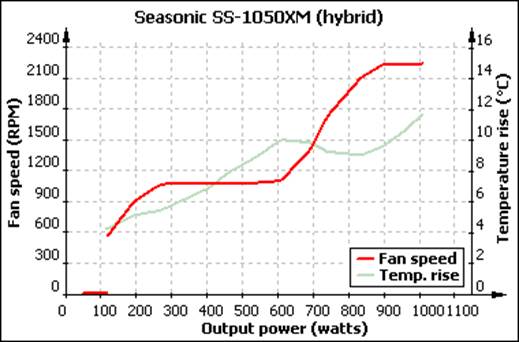
The
graph of temperature and fan speed factors
A sudden increase takes place in speed at
600 watts; the fan reaches its maximum speed at 900 watts - exactly as in the
Normal mode.
Frankly speaking, the cooling system of
this PSU made us disappointed. The initial speed of the fan is too high and
prolonging the passive cooling process in Hybrid mode is too short. That is
unlike the other Seasonic PSUs, so we even doubted that our tested model was
faulty. However, the reports from the users and other reviewers agree with the
results of our testing.
Efficiency and power consumption
factors
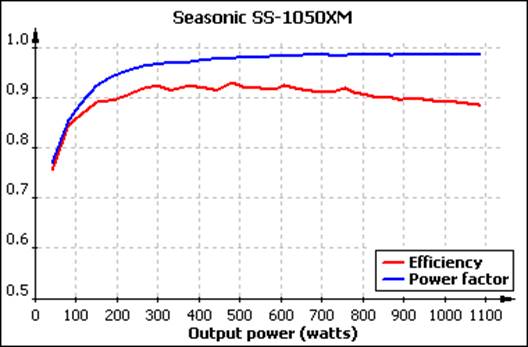
The
graph of efficiency and power consumption factors
At the reference loads of 20%, 50% and 100%,
this PSU reached the efficiency of 90.2%, 92% and 88.5%. Its highest efficiency
of 481 watts was observed at 93.1%.
The efficiency is slightly lower than the
sources discussed above, which is likely to be explained by the difference in
wattage. The higher-wattage PSUs are normally less efficient than their
lower-wattage. Thus, no matter what the reason was, Seasonic’s newer models of
the PSU KM3 still are more effective.
The power factor is nearly 99% at high
loads.
Standby source
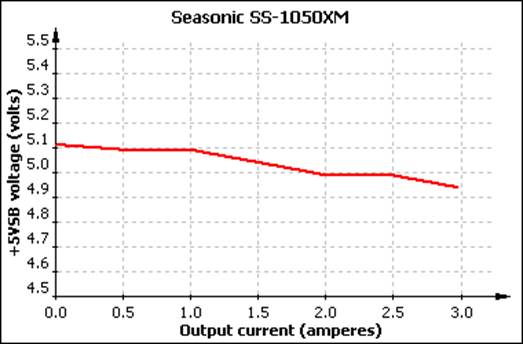
Standby
Source
The standby source works well with the 3A
load easily.
Conclusion
Seasonic’s newest X series PSU versions
from the KM3 subseries keep on inheriting the glorious traditions of the
Gold-certified products of this brand before. They are also similar to their
predecessors if seen intuitively, come with a variety of accessories, provide
higher efficiency and better voltage stability; have a new operating mode for
their fan and a more balanced cable system and are proud of a longer warranty.
The only downside we were able to find in
our tests was the increase of the output voltage ripples as described. On the
other hand, these ripples were within the allowable limits, so it is not a real
problem.
Including leading-wattage product models,
the branch of XM products is not all perfect. Well, it is not worse than the
previous KM series PSUs in voltage stability or efficiency and even provides a
plentiful selection of cables and connectors, but the branch of the KM3 is
better in these aspects.
The main downside of the X-1050 is its
slightly noisy fan. Although the high-quality fans can operate more or less
comfortably at their initial speed of 1,000 RPM; it is hard for you to be
satisfied if you like quiet computers. The Hybrid mode is not particularly
handy because the PSUs will only be passively cooled when being in the idle
mode if you want to have high-performance configurations with numerous graphics
cards.
Therefore, if you are considering choosing
between Gold-certified PSUs from Seasonic, you might want to think twice
whether you really want a 1,000-watt or higher PSU. It is due to the fact that
you can enjoy a lower-wattage model with better parameters. An 850W PSU would
be rather sufficient for even very high-improved configurations with an
overclocked CPU and two graphics cards.